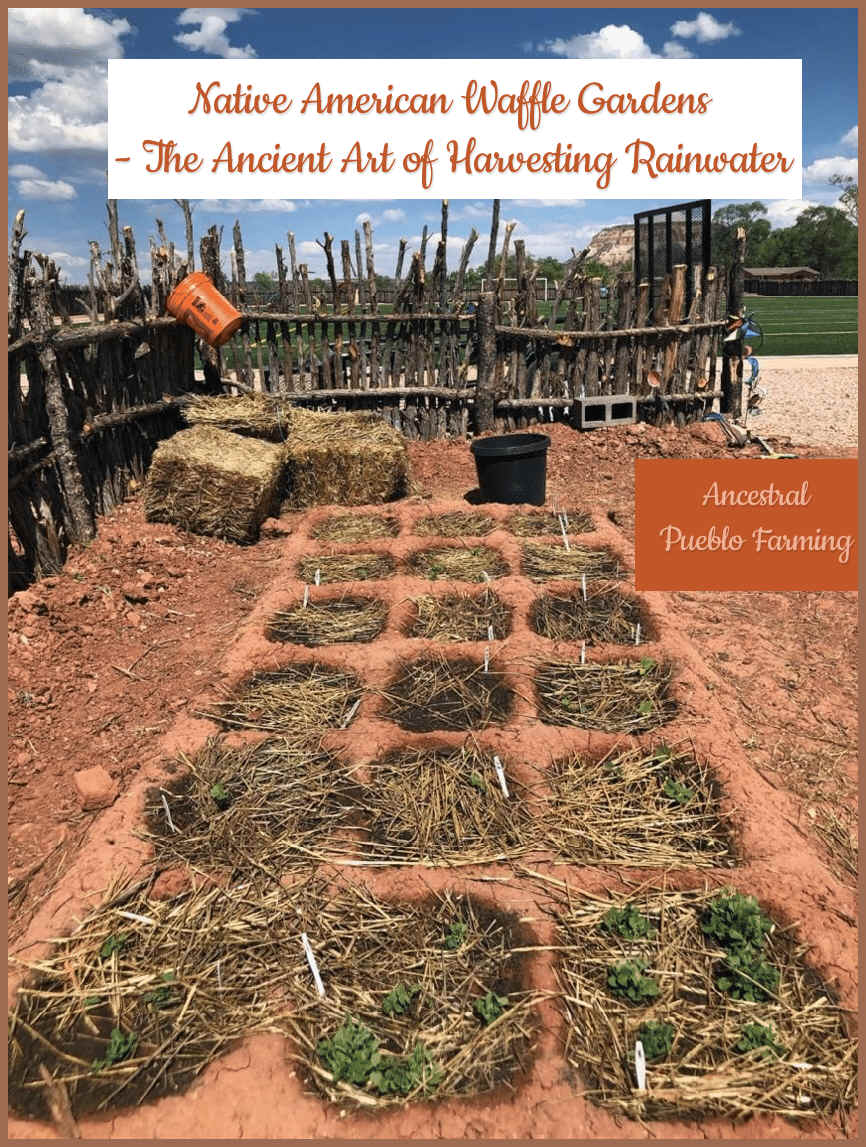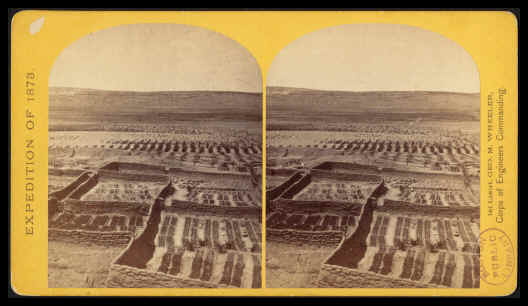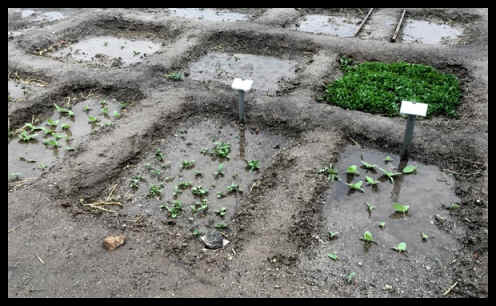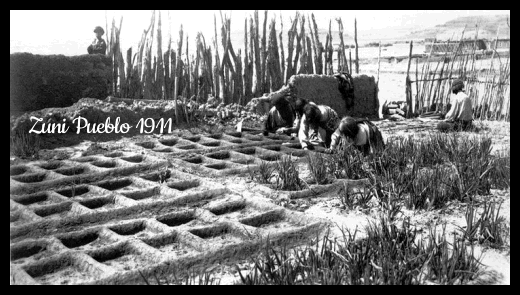Waffle
Gardening - One of the oldest sustainable farming methods of the Southwest.
Dry-Farming.
Water conservation at its best.
In the Southwest, where it’s dry
and arid, people have developed techniques in order to adapt their
gardens to the environment. One such technique is practiced by the Zuni
(A:shiwi) called "Latdekwi:we", or waffle gardening. The Zuni
people, along with other residents in arid regions, continue to practice
the waffle gardening method today. By employing techniques that are
specific to the environment, anyone can grow a healthy vegetable garden,
even in the desert.
The Zuni people felt a close
connection with the environment, and maintained a special relationship
with the natural world for centuries. Through their keen observations,
the Zuni adapted farming skills to the lands in which they lived.
Because New Mexico receives very little rain, the Zuni developed a
dry-farming method – Latdekwi:we. The technique earned the nickname
waffle garden because from above, the layout of recessed beds resembles
waffles.
These and other dryland farming
practices have allowed native people to flourish for thousands of years.
Waffle gardens can be considered the
original “square foot garden.” The garden consists of a grid of
squares, with each square surrounded by berms, or raised mounds of dirt.
The shape helps the water flow directly to the plants. No waste, no
runoff, no evaporation.
Ancestral Pueblo Farming
The ancestral puebloans left no
written record of an epic history. Many of the most spectacular
sites—like the 600 cliff dwellings at Mesa Verde in southern Colorado,
or the enormous pueblo complex of Chaco Canyon in northern New
Mexico—were abruptly abandoned about 900 years ago. Tree-rings and
other data suggest that a prolonged drought, which may have dragged on
for 50 deadly years, caused widespread societal collapse. That history
has become disturbingly relevant, as extreme drought has gripped much of
the Southwest.
For centuries, the Zuni, Hopi, and
other pueblo tribes of the Southwest practiced a type of agriculture
that enabled them to produce bumper crops of corn, beans, and vegetables
in a region that receives about 12 inches of rain annually in good
years—less than a quarter of the precipitation of a corn belt state
like Ohio. Rather than planting and irrigating the same plots year after
year, the Zuni rotated their fields, locating them near the bases of
mesas, in order to capture runoff from seasonal storms. Remnants of
small dams that channeled runoff water have been found at Chaco Canyon,
Mesa Verde, Casas Grandes, and other sites.
Dryland farming techniques vary
between tribes.
-The Hopi plant their cornfields in staggered rows near washes and
arroyos, counting on natural runoff and monsoon rains to water their
crops.
-The Navajo plant their seeds deep - eight to nine inches below
ground - to reach the moist soil.
-The Zuni use terraced farming and
waffle garden beds, where water spills from one depression to the
next.
Waffle gardens are constructed by
forming small depressions surrounded by a low earthen wall. Seeds are
planted within the center of the cavity. Profitable crops like tobacco
and chilis were grown this way.
The Ancestral Pueblo people
developed a number of farming techniques that conserve water. Pumice
(a light, frothy rock that is full of gas) is a major component of the
local volcanic tuff. Pumice can act as a sponge, absorbing water and
releasing it slowly over time. It was used as mulch to preserve
moisture in the soil. Other water-preserving practices included
terracing, check dams that slowed water moving across slopes, and
waffle or grid gardens. The selection of plants was also a good one.
Corn is sun-tolerant and grows tall. Beans and squash are less
tolerant but grown shorter and can be shaded by the corn plants which
also provide support for growing. See
Native American Three Sisters Gardens.
The newest techniques for
conserving water in the garden are actually more than a thousand years
old. American Indians survived for centuries in the desert by
harvesting rainwater to grow crops. And while today’s water supply
may not be as scarce, gardeners still can tap into ancient
water-saving strategies to make the most of every drop.
Methods of water conservation are
becoming more accepted, because people are realizing our limited water
resources. Water-harvesting traditions in the ancients in the Southwest can offer
today’s gardeners lessons in conservation. It's more than rain barrels....
This ancient method is more precise and the water is being used by the
individual plants in that garden.
|
| A waffle garden was
typically intended as the family's kitchen garden. This type of family
gardening was primarily done by the women, because it was situated close
to the main village, and near the primary source of water, the Zuni
River.
Both waffle and grid gardens are
mulched with gravel, sand, or rock. Rock mulch conserves water by
shading the soil and slowing evaporation. Gravel-sized mulch is most
effective during a hard rain because it allows water to be pulled down
into the soil and reduces runoff. Gravel mulch lets all the water flow
through to the soil below. To be effective, gravel must be 2-3 inches
deep. Gravel mulch is very beneficial to plants, and the reflected heat
is not a problem, particularly when planting in the fall and spring. It
is estimated that gardeners could save half of their garden water with
these techniques. Dark gravel
mulch absorbs heat from the sun to keep plants warm at night, and
extending the growing season for tomatoes and eggplants. It also allowed
cotton to be grown in the southwest, where it was normally too cold to
grow. The gravel mulch acts as a dew trap to capture condensation.
Cluster planting is when plants with
similar needs are placed together, a microclimate is created, and less
water is used. A variation on cluster plantings is companion planting. Read
about companion planting here--> American Indians
understood the benefit of planting corn, beans and squash together.
These vegetables are called “The
Three Sisters” , because they complement each other in the
garden.
-Corn provides tall stalks for the beans to climb.
-Beans help replenish the soil with nutrients.
-Squash leaves act as living mulch.
The three sisters can
be planted in a waffle garden, with corn in the middle of the planting
hole, beans surrounding the corn, and squash planted in one or two
corners.
The Anasazi at Mesa Verde also were
skilled at harvesting water from dry lands. The early people of Mesa
Verde were good engineers, and they knew how to harvest water where
modern engineers would say there isn't any. The
Anasazi created a water system that sustained the population. Small dams
and diversions collected rain, and reservoirs stored the water. They
knew how to harvest water, store water and passed that knowledge on.
That knowledge was essential during long periods of drought, one of them
lasting more than 50 years.
Buried clay pot irrigation is
another ancient water-saving method used in places of perennial drought
like Mexico, Central America, Asia and Africa. It’s estimated to be
two times as effective as drip irrigation and 10 times more efficient
than conventional surface irrigation.
While large earthen jars were used
2,000 years ago, today, red, unglazed clay pots work as well. Cover the
hole at the bottom of the pot with masking tape and seal it with silicon
caulk. When dry, bury the pot to its lip in the garden. Place plants or
seeds close to the pot. Fill the pot with water and cover with a simple
lid, such as an aluminum pie tin. Fill the pot as needed. The water will
seep through the pores of the pot, keeping the soil moist. I've done
this in a different way in small garden beds with large unglazed
pottery/clay urns, and it works. Instead of just water in the urn, i
filled it with water, and planted a tall aquatic/marginal ornamental
pond grass inside, and the water seeped out nice and slow. The plant was
happy, the garden was happy, And the pottery urn didn't need an
unsightly lid. It blended in nicely. I didn't bury the entire thing into
the ground. It stood as a decorative and functional piece. It seeped
water just as well from above the ground. Sort of a giant drip
irrigating hose.
Delivering water directly to the
roots has two advantages. Plants receive a constant supply during the
growing season, and weeds are kept to a minimum. Buried clay-pot
irrigation can be used to grow annuals, perennials and container
gardens.
How
To Build The Waffle Garden
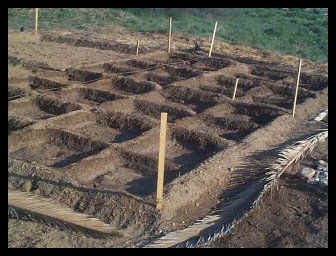
Soil additions were
utilized to produce adequate yields. Just about anything you can think
of growing, that is suitable for your climate, is acceptable in a Waffle
Garden. Vining plants will require more space. In the past, water was
carried by women and children in earthen jars from the nearby river, and
each waffle was carefully watered, one by one, with a dried, hollowed
gourd. Later on jars and gourds were replaced with buckets and dippers.
These days, you can water your garden using a garden hose or watering
can, concentrating the water at the base of plants.
To start making your waffle gardens,
the soil must contain a significant amount of clay in order for the
walls to hold.
First decide how large you want your
squares to be, and this will depend on what type of food you want to
grow.
For example: You can probably fit a few lettuce plants in a 1 foot square,
just as you would in a square-foot garden. Typically, waffle squares are
at least 1 ft. x 1 ft.
Traditionally, waffles are made by hand. Start in one corner of the
garden, and shove the soil to the sides to form a square.
Keep the soil damp, press the soil together to form small walls around 4
inches high x 4 inches wide. Add a bit more water if it is too dry to
hold together.
These small, depressed types of structures make efficient use of space,
act as a barrier against wind, and concentrates the water available near
the plants.
Photo Credits:
Native American Waffle
Gardening, early 1920's photo
Gardens surrounding the Indian pueblo of Zuni, 1873
Zuni Community Waffle Garden, Zuni Youth Enrichment Project
wikimedia
Ashiwi Awan Museum
Research Sources
Ashiwi Awan Museum
Denver Post (2005)
Off -Grid
Grand Canyon Trust
Food and Environment Reporting Network
National Park Service
Native Seeds
Native
American Three Sisters Gardens
Native American Medicine Wheel
Gardens
Native American Farming Wisdom
Detailed
Site Directory-->
Quick Links
Content, graphics and design ©2020 marysbloomers.com
All rights reserved
|
